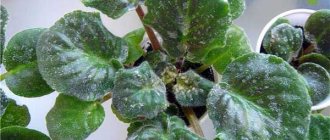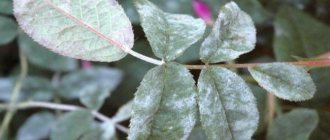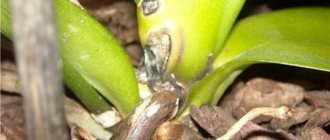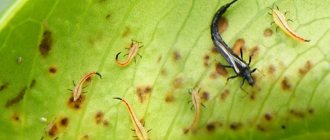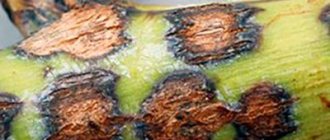What to do with an indoor rose, how to save it if it withers?
First of all, you need to carefully examine the plant for the presence of:
1. Insect pests. 2. Diseases.
Pests of indoor roses
Most often, indoor roses are attacked by ticks. How to define it? This insect is very small; There are types of ticks that are practically invisible - they are so microscopic. But you can always identify a tick by the consequences of its life activity. If you see that the rose leaves have become more faded, have lost their bright, juicy color and some have begun to turn yellow, turn the leaf over and look closely at the surface: most likely you will find tiny, very slowly moving insects of a light brown or slightly darkish color. The leaf on the reverse side will be slightly whitish, as if all the juices have been drunk from it.
A rose leaf affected by a mite.
Spider mites on an indoor rose
If you see a cobweb on a rose bush and very small light brown or black insects crawling on it, this is a spider mite. When a tick is detected, acaricides are needed: “Fitoverm”, “Kleschevit”, “Antiklesch”, etc. To prevent the insect from getting used to the drug, it is better to alternate them. Pay attention to the active ingredient of the drug. Since trade names may be different, but the active substance is the same. It is necessary to carry out at least 2, and preferably 3 treatments with an interval of 7-10 days. Spray the plant until thoroughly wet, be sure to treat the underside of the leaf and slightly moisten the surface of the soil.
2) No less often, aphids settle on roses. She especially loves young twigs and the bases of buds. Aphids are easy to spot because they are much larger than mites. And getting rid of it will not be difficult - just treat the plant with any insecticide suitable for home use. Usually, the death of the insect occurs with one treatment, but for prevention it can be treated again, a week later.
A rose infected with aphids.
3) Scale insects and mealybugs are rare guests on roses. If you find these pests on your home rose, then most likely they are on your other plants and simply crawled or were accidentally transferred to the rose. These pests are much more difficult to get rid of than aphids. At least 3 treatments are needed, with an interval of 7-10 days. Be sure to evenly spill the soil with the same solution until it flows into the pan. The plant is affected by scale insects (1 photo) and mealybugs (2 photos).
4) If, when you touch the plant, small white insects fly up from its surface, a whitefly has settled on your rose. This pest will be the most difficult to destroy. You will need at least 2 insecticides with different active ingredients. You can alternate between Aktar and Fufanon Nova. Be sure to evenly spray the soil with the same preparations until it flows into the pan. At least 3-4 treatments will be required with an interval of 7-10 days.
The plant is affected by whitefly.
Fungal disease of roses: powdery mildew: photo and treatment
Fungal disease of roses powdery mildew in the photo
With the fungal disease of roses powdery mildew, a powdery coating appears on young leaves, shoots and buds; thickening and curvature are observed.
As can be seen in the photo, powdery mildew on roses appears as a whitish coating, which is a mycelium and sporulation of the fungus:
The pathogen overwinters in the form of mycelium in the kidneys. The development of the disease is facilitated by excess nitrogen fertilizer, lack of calcium in the soil, drying out of the soil, too light sandy or, conversely, cold, damp soils.
The disease develops especially strongly with insufficient lighting and high air humidity. Sudden changes in temperature, drafts, drying out of the soil and other conditions that disrupt the normal life of plants reduce their resistance to disease. Tea and hybrid tea roses with more delicate foliage are especially affected.
Rose varieties that are resistant to powdery mildew are those that have dense, glossy leaves of the “Gloria Day” type.
To treat powdery mildew on roses, when the first signs of the disease appear, it is necessary to spray the bushes with Topaz, Chistotsvet, Fundazol or Skor. At temperatures above 22° C, spraying with “Grey colloidal” or “Tiovit Jet” is possible. If necessary, to combat this disease of roses, treatments are repeated as new growth and powdery mildew spots appear on them.
Care after purchase
An indoor rose in a pot is a miniature bush with small green leaves, a large number of stems and flowers at their tops.
When choosing a plant in a store, you need to pay attention that there are no yellow leaves, and that the buds are both open and closed. In this case, with proper care, the flower will delight you with its blooms for a long time.
At home, the plant needs to adapt, so immediately after purchase you must do the following:
- Rinse all the leaves under running water and check for pests.
- For preventive purposes, treat the bush against pests with Fitoverm, and against fungal diseases with Fitosporin.
- Remove faded buds.
- Place the flower pot in a well-lit place where there is no direct sunlight and where it is not very hot.
- Every day, spray the leaves from a spray bottle with water at room temperature.
Within about a week or two, the plant will get used to the new growing conditions and can be replanted.
Rose rust: photos and treatment when fighting the disease
Rust of roses in the photo
With this disease of roses, the affected parts of the shoots become bent and thickened. In spring, orange dust appears on the stems near the opening buds and at the root collar. This is the spring sporulation of the fungus, the causative agent of the stem form of rust. The fungus overwinters in plant tissues infected in previous years. The disease develops more intensely in years with warm and wet springs.
Rust fungi not only take away nutrients from the plant, but also severely disrupt its physiological functions: they increase transpiration, reduce photosynthesis, make breathing difficult and worsen metabolism.
With rose disease, rust on the leaves on the underside in summer, small, red-yellow pads of summer spores form, which can give rise to several generations and infect new plants.
In the second half of summer, winter sporulation begins to appear on the underside of the leaves in the form of small round black pads.
Look at the photo - if this rose disease has severely affected the plant, the entire leaves turn yellow and fall off prematurely:
The spread of rust fungus spores occurs with air flow, water, and planting material.
To protect roses from this disease, one-way nitrogen fertilization should be avoided. In the fall, it is necessary to remove and burn the affected foliage, and in the early spring (before the buds open) spray the plants and the soil around them with iron sulfate (1-1.5%). The soil under the bushes must be loosened and mulched to reduce infection.
To treat rose rust, it is necessary to carefully and promptly trim shoots affected by the stem form of rust; from the moment the buds open, re-spray the plants with Bordeaux mixture (1%) or its substitutes (“Oxychom”, “Abiga-Peak”, “Hom”, “ Copper oxychloride", "Ordan").
Next, you can see photos and descriptions of rose diseases such as black spot, bacterial cancer, gray rot, branch burn and cytosporosis.
Why does indoor rose dry out?
If, during the process of acclimatization, unopened buds began to turn black or the rose flowers began to fall off altogether, this is a signal that the indoor rose was frostbitten or already infested with pests. Such a plant should be removed away from other flowers to prevent them from becoming infected.
The flower does not like dry rooms. The temperature should not be higher than 25 °C. Air humidity is approximately 50%.
Spider mites are another reason why indoor roses dry out. As soon as small cobwebs or the mites themselves are noticed, you should immediately tear off the infected leaves and treat the rose bush with chemicals purchased at a flower shop.
If the rose suddenly dries out, the reason may be due to incorrectly selected soil. Too tight, dense soil will prevent the passage of moisture or, conversely, its stagnation in the root system, which will lead to rotting and drying out.
Timely loosening and fertilizing of the soil will solve some problems and prevent premature wilting. The bush should be replanted in a more suitable soil after washing the roots with a weak solution of potassium permanganate.
Bacterial rose cancer disease: photo and treatment of flowers
Bacterial rose cancer disease in the photo
With bacterial canker of roses, growths of varying sizes form on the root collar and roots of plants. Sometimes they are barely noticeable, but often reach several centimeters in diameter. The growths have an uneven tuberculate surface. They consist of soft tissue, first white, then brown, and are decomposed by bacteria in the soil.
There are also hard, lignified growths that grow every year. Less commonly, the above-ground part is affected - trunks and branches, mainly in climbing and standard remontant roses. Here, tuberous nodules and tumors of various sizes are formed.
Transfer
Replanting a rose is not difficult. The question is: Will it take root? The death of a rose after transplantation, unfortunately, happens often, because this flower is very capricious. Therefore, if, when removing a plant from a pot, you notice darkened and limp roots, it is better not to take risks and do not cut off the diseased areas, but try to grow a new rose from this cuttings (see the next section Reproduction ).
So. How to replant a rose?
Photo 3. Transplanting an indoor rose
- After removing it from the old pot and inspecting the root system, prepare a new pot - low and with dense walls and a tray.
- Almost a third of the pot is filled with expanded clay or broken brick (you can use other small stones).
- A little substrate is poured - coniferous soil, leaf soil, humus, sand, turf soil (proportions 1: 1: 1: 1: 3). You can buy land - ask for soil mixture for roses (indoor or garden).
- The bush itself is carefully positioned (it does not have to be completely cleared of old soil).
- Add soil almost to the edges of the pot (a little more than 1 cm is left).
- The bush is watered and treated with the necessary means (this is mentioned several times in this article!).
Fungal disease burn of rose branches: photos and control measures
Fungal disease burns rose branches in the photo
Branch burn is a fungal disease in which reddish spots initially appear on the branches, later darkening in the middle; the red-brown border persists for quite a long time. As the spots grow, they ring the branches. Tissue sagging may form above the affected area. Diseased branches usually dry out at the end of summer.
The development of “burn” is facilitated by excess humidity under the winter shelter.
To avoid severe damage to roses, cover should be removed earlier in the spring. Sick and frozen branches must be pruned and burned in a timely manner.
As shown in the photo, when treating this disease of roses, plants need to be sprayed with preparations containing copper, as in the fight against rust:
Proper agricultural practices (timely application of fertilizers, loosening and watering) help reduce the severity of the disease. It is necessary to achieve good ripening of the wood until the end of the plant growing season.
For the winter, plants with already fallen leaves should be covered in dry weather if possible, so that increased humidity is not created under the cover. Before covering, unripe shoots with green leaves are removed, and the plants are sprayed with a 3% Bordeaux mixture or a 1.5% solution of ferrous sulfate.
Distribution routes
The mosaic virus is resistant to negative factors. It does not die at extremely high and low temperatures. It overwinters successfully in the garden on plant debris in the soil, on host plants, and remains active in collected seeds.
If the source is seeds, then signs of infection appear in the early stages of seedling development. If it all started during planting, then external signs appear within a month.
The common cucumber mosaic actively develops when the temperature drops sharply, while the speckled and tomato mosaic, on the contrary, “bloom” at an ambient temperature of 30°C and above.
A healthy plant can be infected during picking, pinching or grafting. In this case, the virus is transmitted through gardening tools and tools.
The spread of the disease in the area is also caused by sucking pests (aphids, mites). 70 species of aphids are known to carry mosaic disease. After the virus enters the body of an insect, it goes through an incubation period (multiplies) and at the next “meal” it is transmitted to the tissues of a healthy plant.
The speed of spread is affected by the age of the plant and growing conditions. Young seedlings experiencing various types of stress (high or low air and soil temperatures, lack of moisture or nutrients) are more often susceptible to diseases.
Related article: Apartments in Temryuk: the resort town has become accessible to everyone
Treatment of roses to protect against cytosporosis disease
Cytosporosis is a fungal disease of roses in the photo
Cytosporosis is a fungal disease that is widespread throughout the world. Roses affect a number of ornamental shrubs, as well as pome and stone fruit trees and nuts.
Cytosporosis is also called infectious drying out. In some years, it leads not only to the drying out of individual branches, but also to the death of plants. Bushes that are weakened as a result of freezing, drought, sunburn, untimely pruning, etc. are especially susceptible to this disease.
First, the causative agent of the disease settles on dying individual areas of the bark. Large, clearly visible orange-red fungal pycnidia tubercles appear over the entire area of the affected bark, protruding from under the skin.
Try varieties of hybrid tea roses from a trusted supplier:


